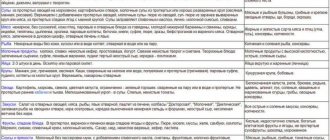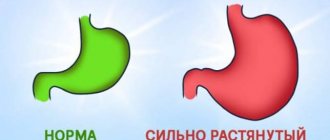Most methods of combating excess weight are based on restricting diet and increasing physical activity. But in severe cases of obesity, gastric resection may be prescribed. This is a radical measure that is carried out in exceptional cases and has a number of nuances.
The information presented here is of interest from a purely educational point of view. It cannot be used to decide whether a particular case requires resection or not. Only a doctor can determine this.
What is gastric resection, the essence of the operation
Gastric resection was initially used only to treat certain diseases of the gastrointestinal tract. It involves partial cutting off or complete removal of the stomach. This can be longitudinal removal or using the Balfour method. After such an operation, the functionality of the gastrointestinal tract is restored. Not so long ago, this kind of intervention was used only when all other methods of treatment had been exhausted and the person was in danger of dying. But recently, resection has been prescribed for the treatment of terminal obesity.
As a result of the operation, half, a third or a quarter of the stomach may be removed. Sometimes subtotal resection is used, in which 80% of the organ is removed. The size of the removed part depends on the level of obesity. After rehabilitation, a person adapts to living with a reduced stomach. It takes less food to fill it, so the portions become noticeably smaller. As a result, the number of calories consumed is reduced, and the patient begins to lose weight.
But that is not all. It is very important to eat right after surgery. You need a balanced, well-thought-out diet. If you improve your diet, your weight will gradually become satisfactory.
How to eat food correctly so that your stomach shrinks
The normal volume of the organ is 500-600 grams. With an ever-increasing appetite, its capacity increases to 4 liters.
1. Establish nutrition
Proper nutrition is important for losing weight! When you eat food quickly without chewing thoroughly, its amount increases significantly, but it can be reduced if you chew the food slowly. Thus, the time spent eating a small portion will not exceed 25 minutes. This is enough to make you feel full; it is during this time that food enters the digestive system.
Conversations or other activities should also not interfere with eating, to which all your attention should be directed. The stomach will “remember” the amount of food that enters it every day and its volume will gradually decrease.
2. Improve your diet
It is easier and smarter to reduce a distended stomach at home by choosing the right products. Every day's menu should include dishes containing fiber to stimulate metabolism and maintain a feeling of fullness.
3. Control the water regime
Eating right means drinking fluid in the required amount, which is 2-2.5 liters per day.
You should not drink water with your food either during or after meals. The volume of the stomach increases if liquid enters it with food.
4. Limit harmful foods
It is worth giving up sauces and fatty foods - because of them, the appetite increases and, as a result, the size of the stomach “grows” again.
Add bran to your dishes; as they swell, they fill the stomach and what you eat takes longer to digest, which allows you to forget about the feeling of hunger for a longer time.
5. Liquid diet
This proven method is recommended by many experienced nutritionists. For two days a week, for example, one day on the weekend, and the second in the middle of the week, do not eat solid food, only liquid food.
Drink fruit and vegetable juices, kefir, water and herbal tea without sugar every 2 to 3 hours. On the rest of the week, eat low-calorie meals. On other days, follow a low-calorie diet. In just 1 week you will feel the result, lightness will appear, and your stomach will tighten.
6. Reduce portions
To eat less, choose small plates and portions the size of two fists. Do not exceed this volume.
The capacity of the stomach can be determined by putting 2 fists together, and the required portion of food can fit in two palms. This is the amount of food you can eat at once.
7. Eat slowly , chewing thoroughly for at least 20 minutes.
Benefits of the procedure
Distal gastrectomy allows you to achieve truly impressive results. In just six months or a year after it, people lose from 50 to 90% of excess weight. The rehabilitation course is very short, patients quickly return to normal life, since minimal incisions are made during the operation, and the scars are very small.
During the resection process, only the stomach is affected. The remaining organs of the gastrointestinal tract continue to work. The operation is performed once. Repeated interventions or corrective procedures are usually not required. The remaining part of the stomach will forever retain its new size, so satiety will occur with less food consumption.
Benefits of adjusting the digestive system
Not everyone who wants to lose excess weight knows how to make their stomach volume smaller, so they limit the amount of food they eat as much as possible or, worst of all, start using “magic” pills and other dietary supplements that supposedly will help achieve what they want, while you can adjust the size in completely safe ways - exercise and proper nutrition!
When the stomach decreases in volume, the following beneficial changes occur:
- The process of digesting food returns to normal due to the fact that less food gets into it and its absorption occurs more efficiently.
- Weight is reduced and metabolism is restored.
- The likelihood of diabetes is significantly reduced.
- Gastritis and ulcers are successfully treated.
- General well-being improves, activity increases, and immunity increases.
As for surgical interventions, this is an option only for the most hopeless cases.
Flaws
This operation has its negative consequences. For example, after excision the stomach has reduced peristalsis; a person with a reduced organ may face the problem of intestinal obstruction. When a staple seam is performed incorrectly, inflammatory and infectious processes sometimes occur. Therefore, it is very important to be observed by a doctor during the postoperative period.
Gastric truncation is an irreversible procedure. Having made a resection once, it is no longer possible to return the organ to its original state. Sometimes a hernia forms at the sites of micro-incisions and sutures.
The first six months after surgery undergoes a process of adaptation of the body. During this time, such phenomena as constipation, diarrhea, and flatulence are common. There are side effects that do not go away even after the end of the adaptation period - heartburn, spleen diseases, stomach bleeding, inflammation of the abdominal cavity. If you look at the reviews, you can see that all sorts of complications of this kind are not uncommon.
Among other things, the passage of solid food with an excised stomach will be difficult. The first time after the procedure, abdominal pain appears when eating solid food. Over time, the pain goes away, but mild discomfort may remain.
Effect of liquid on the stomach
When wondering whether water stretches an organ, it should be noted that its volume should correspond to physical activity, climatic conditions, hormonal and metabolic processes, and the amount of food consumed.
Liquid helps dissolve and remove harmful substances from the body, so large amounts of food should be washed down with a significant amount of water.
On average, a healthy person needs 1.5-2 liters per day, but these norms are adjusted individually.
Water passes through the digestive tract in transit, so it does not linger in the stomach and cannot cause it to stretch. And even an increase in volume will only affect the metabolic process, but not the size of the organ. Therefore, what you should be afraid of is not an extra glass of liquid, but an addition to the portion, since water does not stretch the stomach.
Comparison of the method with other methods of stomach reduction
There are several other surgical methods to reduce the absorptive surface of the stomach. Each of them has its own characteristics and is prescribed for certain indications.
Ballooning
With this technique, a silicone bladder is inserted into the stomach, which is then filled with saline solution. Being inside the stomach, the bubble creates a feeling of fullness, as a result of which a person eats much less. After it is performed, the patient can immediately go home, and after resection, he must spend at least 3 days in the hospital. But ballooning ensures a loss of only 40% of excess weight, and resection – from 50 to 90.
Ballooning is a fairly simple medical procedure that does not involve surgery. During the first days after the procedure, nausea and vomiting are possible. But these complications are not nearly as serious as the possible consequences after organ truncation surgery.
After 6 months, the balloon should be removed. During this time, a person, theoretically, should get used to small portions. But if he resumes his previous eating habits, the weight will increase again. Another nuance is that sometimes the balloons burst right inside the stomach. This can happen without a person noticing. Therefore, the saline solution with which it is filled is colored blue. If the balloon suddenly bursts, the saline solution will turn the urine blue, and the patient will see this the first time he urinates. Blue urine for people with ballooning is a signal to urgently go to the doctor and remove the balloon.
Bandaging
This procedure involves placing a bandage – a silicone ring – on the stomach. The ring compresses the stomach, dividing it into two parts. At the site of compression, a gap as thick as the esophagus is left. The upper part of the stomach turns out to be very small. Food goes into it first. It fills quickly and signals that saturation has occurred. Then gradually the food moves to the lower part of the stomach, and then to the small intestine.
After the bandage, the person spends one day in the hospital. The procedure allows you to lose up to 50% of excess weight. Banding is performed using a minimally invasive method, which is much easier for the patient than a full-fledged surgical intervention such as resection. Complications with banding are the same as in other cases when a foreign body is placed inside.
Gastroplication
This is a method in which the stomach is folded in its expanded part and sutured in a special way, after which it takes the shape of a tube. It is performed laparoscopically, without organ incisions. Provides loss from 35 to 50% of excess weight. After the procedure, you may have problems eating. Long-term results have not yet been studied, as the technique has only recently become widely used.
Bypass surgery
During bypass surgery, a small part of the stomach is separated from the main one and connected to the small intestine in a bypass. After the procedure, the capacity of the working part of the stomach is reduced, and the degree of absorption of nutrients decreases. Bypass surgery is an even more complex surgical operation than resection. After it, patients remain under the supervision of doctors even longer.
The result of bypass surgery is a loss of 70 to 80% of excess weight. But quite serious complications can arise in the form of insufficient absorption of microelements and vitamins. Vomiting and nausea often occur.
In this case, the weight comes off within a year or two. After this, the person’s condition stabilizes, and if one does not return to harmful eating habits, the slim figure is maintained. If necessary, you can restore the original shape of the stomach.
Why reduce your stomach?
The main factors are excess weight and increased parameters of the organ itself, as well as:
- Lack of systematic eating, if a person eats a large amount of food, but infrequently.
- Drinking food with too much water or other drinks.
- Prolonged, dense overeating.
- Eating food in the absence of real hunger.
- The causes of increased stomach volume are anatomical.
This organ is a kind of container in which what is eaten remains for a long time, exposed to gastric juice. Then its small parts enter the duodenum, in which food is broken down and absorbed.
However, the longer the time food remains in the stomach, the more its volume increases! This should be kept in mind by anyone who wants to lose weight.
Indications for resection
Gastric resection is indicated for complex obesity, which is accompanied by severe pathologies:
- metabolic syndrome;
- apnea (short-term cessation of breathing during sleep);
- pulmonary or heart failure;
- joint diseases;
- phlebeurysm;
- hypertension;
- infertility;
- diabetes.
The appointment is made taking into account the fact that excess weight has already led to concomitant diseases, and can further aggravate the person’s condition, as well as the fact that the person himself is no longer able to get rid of obesity in more natural ways. It is also clarified that the procedure allows you to remove no more than 50 kilograms.
Who is gastroplasty indicated for?
Longitudinal gastrectomy has the same indications as other bariatric surgeries. We consider the possibility of surgical intervention in the following cases:
- your body mass index is more than 40 kg/m2 (morbid obesity);
- BMI is above 35 kg/m2, if you have recently gained a lot of weight or have undergone a course of conservative therapy, which was ineffective;
- an intragastric balloon was previously installed, but this did not allow achieving the desired effect (“refractory” to balloon surgery);
- excess weight is accompanied by the presence of diabetes mellitus, arthrosis of the joints, severe hypertension and other pathologies associated with obesity.
For patients whose BMI exceeds 50 kg/m2, sleeve gastroplasty is performed only in combination with bypass surgery. Without this, the operation may be ineffective. Each case is considered separately by our surgeons. We take on work only if we are firmly convinced that the proposed procedure will help you get rid of excess weight and start a new life.
Contraindications to gastric resection
It is immediately worth noting that obese people, as a rule, have a whole bunch of diseases, and some of them are a contraindication to resection. Therefore, patients who are ready to go under the surgeon’s knife and pay a lot of money for it are often denied the operation.
Contraindications:
- autoimmune connective tissue diseases;
- taking hormonal steroid drugs on a regular basis;
- age under 18 years;
- alcoholism;
- kidney diseases;
- psychical deviations;
- chronic gastrointestinal diseases;
- ascites.
The procedure cannot be performed if there are inflammatory processes in any organs. Among other things, the anesthesiologist must give permission for the operation, since it is performed under general anesthesia. Therefore, one should also take into account contraindications to anesthesia, and this is a whole range of cardiovascular, pulmonary and other diseases that often affect obese people.
Are such operations dangerous?
Most people who want to lose weight, but do not know about other ways to narrow the stomach and reduce appetite, tend to undergo surgery at the first opportunity. However, any surgical procedure has specific dangers. For this reason, doctors always notify about side effects.
It should be noted that after any type of operation, medical supervision will be required.
Taking vitamin and mineral dietary supplements, as well as a special diet, will be for life! Therefore, before resorting to such drastic weight loss measures, it is important to evaluate all the positive and negative aspects so as not to suffer from serious consequences in the future.
What recommendations should be followed after surgery?
After gastroplasty, you will need to follow a certain diet. On the first day, hunger is necessary. To avoid dehydration, we will give you intravenous fluids in the form of IV drips. From the second day, it is allowed to drink water, broth or low-fat milk, 1 spoon every 20 minutes. This regime must be followed for a week. This will prevent undue stress on the stitches and allow them to heal. Later you can switch to semi-liquid and pureed foods.
A return to normal nutrition will be possible in 2-3 months. In this case, you will need to adhere to the principles of rational nutrition, eating 5-6 times a day in small portions. Between meals, you will consume liquid in a total volume of up to 2 liters per day. Your surgeon will select an individual diet for you. The doctor will also prescribe multivitamin and mineral complexes that will help avoid hypovitaminosis. If you follow all these recommendations, you do not have to worry about weight gain again.
Normal human stomach
The presence of muscles in the walls of the stomach and its functionality imply its intense motility. Its peculiarity is an increase in size due to stretching. A normal stomach has a volume of up to 500 ml, which is equal to two glasses of food. The food portion size should correspond to two clenched fists.
Please note: When overeating, it increases greatly, but then returns to its normal size. If you constantly overload it, it can reach a volume of 4 liters. But this happens extremely rarely. More often it stretches to 1.5 liters, which also depends on the person’s gender, age, physique and genetics.
The main causes of stomach distension
There are many diseases that are complicated by stretching of the stomach walls. However, most often the reason for the increase in the volume of the main organ of the gastrointestinal tract is the constant consumption of large amounts of foods high in fiber, as well as legumes, which provoke active production of intestinal gas. Pathological aerophagia (swallowing air) is also one of the most common causes of stomach distension. In some cases, the pathological symptom occurs due to milk or lactose intolerance, food poisoning, parasitic infections, peptic ulcers, celiac disease.
Cirrhosis and heart failure can also cause the walls to stretch. In both of these conditions, fluid accumulates in the abdomen (ascites), which creates a feeling of fullness. Thus, to the question “is it possible to stretch the stomach with water?” a positive answer is given. It’s just that water does not enter the body from the outside, but accumulates from the inside, stretching the abdominal cavity.
Other pathological causes of a distended stomach:
- intestinal diseases (irritable bowel syndrome, ulcerative colitis, Crohn's disease, persistent constipation, functional dyspepsia);
- taking certain types of medications, including antispasmodics and antidepressants;
- acute pancreatitis;
- diverticulitis;
- cystic fibrosis;
- stomach stones;
- eosinophilic gastroenteritis;
- peritonitis;
- malabsorption syndrome;
- fascioliasis;
- hernia;
- cancer diseases.
Naturally, one can only suspect gastric distension on one’s own. Only an image will allow the doctor to assess the size of the main organ of the gastrointestinal tract.










